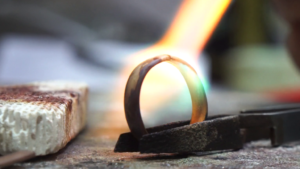
Successful soldering, annealing, melting, reticulation, enamelling, along with many other jewellery techniques requiring heat, starts with the right torch for the job. Each torch set up has its pluses and minuses, and particular uses. As jewellers, we become very attached to our tools, and every jeweller swears by their chosen torch. It may be perfect for them, but are they making what you are making?
The one thing all torches have in common is that they produce a flame, after that it gets more interesting. Just like lovers, not all flames are created equal. Some flames are hotter and more intense than others, and some, more adaptable than others. When choosing a torch, you first have to determine what type of flame you are looking for. One other important factor is figuring out what type of set up you are able to accommodate. Because along with the ability to produce a flame, they can also cause a fire. Consider your available space, budget, ability to create a safe work environment, home insurance and building codes. You may want an oxygen/ acetylene set up, but if you are working in the corner of your living room attached to 5 other families in a townhouse, this may not be the most responsible or allowable option.
There seems to be a vast variety of jewellery torches on the market, choosing a torch is not a simple task, it will take some time getting to know them all a little bit. It’s better to date a little before diving into a love affair, and it’s advised to take a little time selecting before you bring a torch home.
A torch is made up of a handle for the flame, attached to a fuel source. The most basic torch consists of a fuel tank and a handle. These are the hand torches, also known as micro torches. Then there are handles that attach to a fuel tank with a hose. Some of these handles have different tips to adjust the flame size. Others have a knob to adjust the amount of gas released as well as different tips. Some tanks need regulators, others don’t. And then there are those with separate gas and oxygen tanks, both with regulators and attaching to the handle with separate hoses.
Let’s start with the basic necessity, the fuel source. Different fuels burn at different temperatures producing a flame used for a certain number of applications, and some are safer than others. When choosing a fuel source, keep in mind that some torches are designed to only work with a specific fuel. Here is a list of a few common gases used in the jewellery trade. Please do your due diligence and check the proper handling and storage of gases before bringing them into your home or studio.
Butane:
- burns at a lower temperature 1970 c
- affordable and easy to find, local hardware store
Propane and Natural Gas:
- lower temperature approx. 1967 c
- affordable and easy to find at local hardware stores
- different tank sizes available
- has an odour, sinks in air and has the lowest flammability range
Acetylene :
- burns at a higher temperature 2500 c
- may leave soot, only a issue with some gold and platinum
- purchase at a speciality supplier
- improper storage leads to gas being unstable
- ignitable over a large range of concentrations, easy ignition
Hydrogen:
- burns hot and clean 2210 c
- not easy to source
- more expensive and requires special handling and storage
At Workingsilver, we have two great mini torches that are perfect for a variety of jewellery applications, (and crème brulee if you get a bit peckish from all your jewellery work). Mini torches are easy to use, refillable with butane, and inexpensive.
Some jewellery applications you can do with a Micro flame torch are: melt balls on ear wires, anneal and solder ½” earrings with a bezel, make 14 gauge and under jump rings, make a 4mm wide ring band, torch fire some small metal clay (pmc) and produce heat patina on copper.
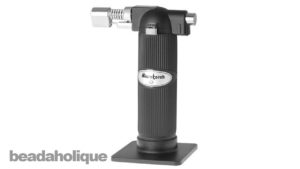
The Big Buddy Torch also uses butane, it has a larger flame than the micro-mini, and its flame is adjustable and lockable. It also can be used at multiples of different angles. It can do all a micro mini can as well as: create silver pendants 1 to 1 ½”, solder ear wires to earrings, 12 gauge and thicker jump rings, 5mm ring bands, attach a bezel to a ring, anneal sheet metal and torch fire enamel rings and pendants. We have this torch in a variety of fun colours too!
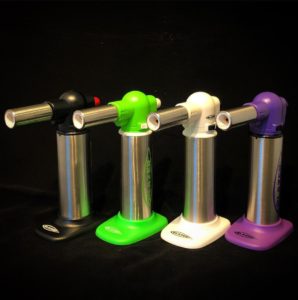
Atmospheric torches are the most common type of torches used in studios and schools. They use pressurized propane, butane or acetylene and ambient oxygen from the air, which mixes at the torch head. With some of these torches, regulators are required, as is with the acetylene torches we use at Workingsilver. Flame size can be adjusted by the pressure of the gas released, the amount of gas by the knob at the torch head, and using different size tips at the torch head. These types of torches are perfect for silver jewellery applications and can perform almost any task sufficiently. Along with what a mini torch can handle, much bigger jewellery pieces can be made such as large rings, cuff bracelets, huge heavy pendants, melting silver for water casting and ingots. Brands of this type of torch are the Smith silversmith, presto-o-lite, and the whale torch (aka orca, whale, or copperhead torch)
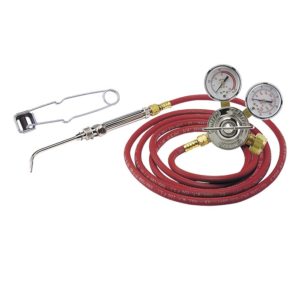
Acetylene Air Silversmith Torch
Propane Air Silversmith Torch (Orca Torch)
 Propane Air silversmith Torch (Orca Torch)
Propane Air silversmith Torch (Orca Torch)
Gas and oxygen torches these torches use pressurized gas as well as pressurized oxygen tanks and require separate regulators, and separate knobs at the torch head for adjusting amounts of gas and oxygen released. Acetylene, natural gas, propane, and butane are used with these torches. This set up is the most complicated to use, the most hazardous, most costly, but also affords you the most adjustability as far as flame size and heat. Brands of this torch type are the Hoke torch, Meco midget, and the Smith mini torch. If you are a goldsmith this is what you need, but for most silversmiths, I would say it’s unnecessary.
Soldering Tools and Supplies are available HERE
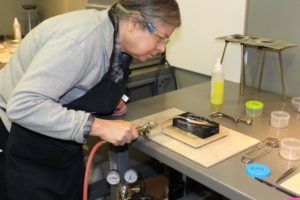
Written by Serena Bartok
